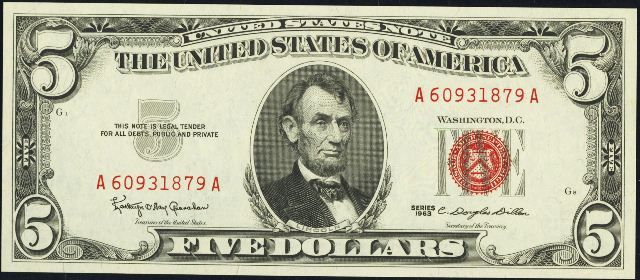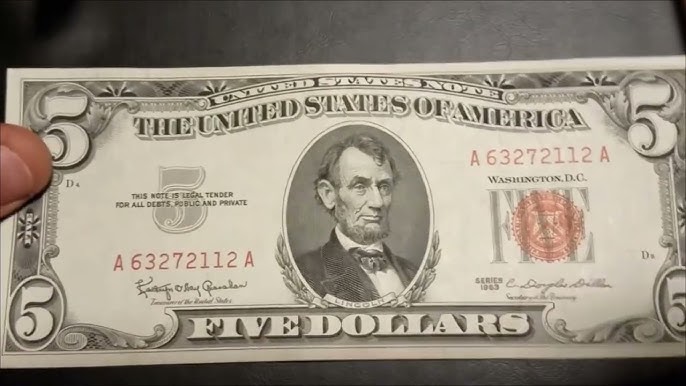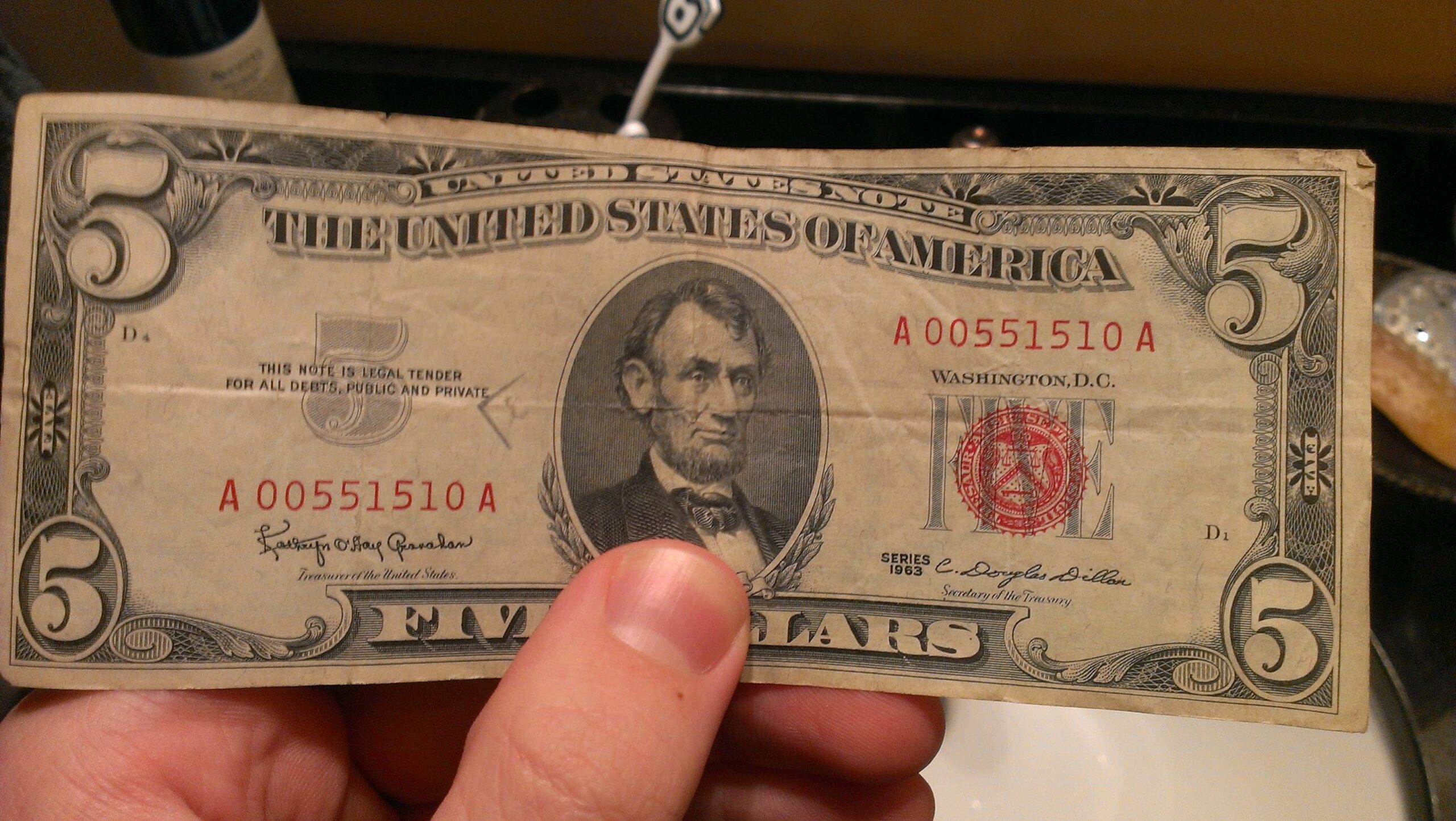If you’ve recently come across a 1963 $5 bill, you might be wondering: “What is the value of a 1963 5 dollar bill?” The value of these bills can vary depending on their series, condition, and even any special features such as star notes or errors. This article will explore the worth of 1963 $5 bills, including those with red and green seals, their history, and factors that can influence their value.
You’re a casual collector or a serious numismatist, understanding the value of a 1963 5 dollar bill can be quite rewarding.
The Basics of the 1963 5 Dollar Bill
Before diving into the specifics of the value of a 1963 5 dollar bill, it’s important to understand the basics of the note. There are several types of 1963 $5 bills, but the two most common are the red seal legal tender notes and the green seal federal reserve notes.

The red seal notes are especially notable because they were the last series of $5 legal tender notes ever issued.
However, most of these notes were printed in large quantities, and unless they are in perfect condition or feature unique characteristics, they are generally not worth much more than their face value.
The 1963 $5 red seal bill is a legal tender note, meaning it was issued directly by the U.S. Treasury and was not tied to a specific amount of gold or silver. It was part of a larger trend in U.S. currency during the 1960s, which saw several key design changes.
One such change was the addition of the motto “In God We Trust” to the reverse side of the bill, located above the iconic Lincoln Memorial.
The Value Of The 1963 5 Dollar Bill
So, what is the value of a 1963 5 dollar bill? Most 1963 $5 bills aren’t very valuable, especially in circulated condition. In fact, many bills in average condition are worth little more than their face value. However, certain conditions, series, and special characteristics can significantly increase their worth.
Standard 1963 Red Seal $5 Bill
The 1963 red seal $5 bill in average circulated condition is generally worth around $5 to $10. A bill that has been well-preserved but shows minor signs of wear, such as slight creases or folds, can be valued at around $8 to $13.
However, uncirculated notes or those graded as MS 63 (choice uncirculated) can fetch a much higher price—typically around $25 or more.
Star Notes
One of the most sought-after varieties of the 1963 $5 bill is the star note. A star note is a replacement note that was issued by the U.S. Treasury to replace a damaged or misprinted bill. These star notes are rarer and thus more valuable than regular notes.
For a 1963 red seal star note, you can expect it to be worth $22 to $30 in very fine condition, and $90 in uncirculated MS 63 condition. Notes with higher grades or unique features can sometimes go for even more.
For example, a star note in excellent condition with a rare serial number might sell for a premium price.
1963 Green Seal $5 Federal Reserve Note
Another type of 1963 $5 bill is the green seal federal reserve note. These notes were part of a different series, featuring a green Treasury seal and were issued by the Federal Reserve rather than directly by the U.S. Treasury.
A 1963 green seal federal reserve note in circulated condition typically has a value of $5 to $7, similar to the regular red seal bills.
However, star notes from the 1963 series with a green seal are a bit more valuable. In very fine condition, you can expect these star notes to be worth $25 to $35, while uncirculated examples can be worth $100 or more, depending on their grade and rarity.
1963A Series Green Seal $5 Bill
The 1963A series of green seal federal reserve notes is similar in value to the 1963 series. These notes were issued just after the 1963 series and follow similar design features. However, the 1963A series is generally less valuable than its earlier counterparts.
In most cases, the value of a 1963A $5 bill is comparable to the 1963 series, though some rare star notes or well-preserved examples could command slightly higher prices.
Factors That Affect the Value of a 1963 $5 Bill

Several factors can influence the value of a 1963 5 dollar bill. These include:
- Condition: The condition of the bill is one of the most important factors in determining its value. Bills that have been well-preserved with minimal wear, creases, and folds are generally worth more. A bill that has been graded as MS 63 or higher is considered uncirculated and will command a premium price.
- Star Notes: As mentioned earlier, star notes are replacement bills that are rarer and more valuable than regular notes. The more rare and pristine the star note, the higher its value.
- Errors: Occasionally, bills may have printing or production errors that make them more valuable to collectors. Common errors include misprints, double printing, or ink smears. Errors can add value to a 1963 $5 bill, but they are typically rare and should be authenticated by a professional before attempting to sell.
- Serial Numbers: Some collectors are interested in bills with unique serial numbers, such as low serial numbers or notes that contain repeating numbers. These notes can be more valuable, especially to collectors who specialize in this area.
- Series and Seal Type: The type of seal (red vs. green) and the series (1963 vs. 1963A) also play a role in determining value. Red seal bills are generally rarer than their green seal counterparts and may carry a slightly higher premium.
Collecting the 1963 5 Dollar Bill
If you are interested in collecting 1963 $5 bills, there are several things you should consider. Start by familiarizing yourself with the different types of bills, their series, and seal types. Pay attention to the condition of each bill and the presence of any unique features such as star notes or errors.
It’s also important to keep in mind that not all 1963 $5 bills will be worth a significant amount of money. Bills that have been heavily circulated or are in poor condition will typically only be worth their face value.
However, uncirculated notes, especially star notes or those with errors, can be valuable additions to your collection.
Conclusion: What is the 1963 5 Dollar Bill Worth?
So, what is the final answer to the question, “What is the value of a 1963 5 dollar bill?” For most bills in circulated condition, the value is around $5 to $15. However, star notes, especially those in uncirculated condition or with rare serial numbers, can be worth much more—ranging from $25 to $100 or higher. Errors, such as misprints or ink smears, can also increase the value of these bills.
If you have a 1963 5 dollar bill, it’s important to carefully assess its condition and any unique features it might have. While most bills from this series won’t make you a fortune, rare examples and well-preserved notes can provide collectors with a worthwhile investment.
Looking to sell your 1963 $5 bill or simply want to learn more about its history and value, understanding the nuances of these bills will give you a deeper appreciation for their place in U.S. currency history. So, next time you find a five dollar bill from the 1960s, take a closer look—it might just be worth more than you think!

